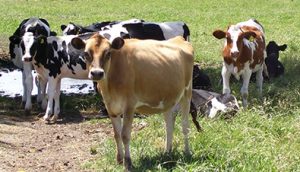Read the latest information on
Foot-and-mouth disease
 With large parts of the country receiving some much-needed rainfall, many livestock producers are considering restocking or increasing their existing herds and flocks. While this is good news for those businesses, Animal Health Australia (AHA) is advising producers to be cautious with how they go about restocking.
With large parts of the country receiving some much-needed rainfall, many livestock producers are considering restocking or increasing their existing herds and flocks. While this is good news for those businesses, Animal Health Australia (AHA) is advising producers to be cautious with how they go about restocking.
Whenever livestock move there is a chance of them taking diseases, pests and weed seeds with them, according to Dr Rob Barwell, Senior Manager for Biosecurity at AHA – and this increases even more when animals from a number of herds and flocks come together.
“If you’re bringing stock onto the property, it’s worth isolating them from your existing stock and monitoring them and their paddock or yard for signs of a biosecurity incursion” Dr Barwell said.
“How long this might be will depend on the conditions those stock may be impacted by, but generally 21 days is long enough to see signs of diseases and pests, while 48 hours is enough to empty of weed seeds.”
It’s also important to ensure the property is ready for any new arrivals, as fencing and infrastructure may have been damaged by fire, floods or heavy rainfalls.
Likewise, with rain comes new growth, and pastures may be affected by sprouting weeds, many of which can make livestock sick. It’s also likely you’ll see more insect pests and parasites, which can be bad news for your animals.
“It’s important to ensure that pasture is nutritionally appropriate and not infested with weeds or parasites,” Dr Barwell explained.
“Good conditions for livestock are often good conditions for things that can make them sick, too.”
Making sure you know the health history of any stock you bring in is also vitally important.
“Asking for a national Animal Health Declaration means you’ll receive information about the health of those animals, including when they were last vaccinated, drenched or otherwise treated for a number of common conditions,” Dr Barwell said.
“This lets you make informed decisions regarding how you will manage their introduction to your property and their health going forward.”
Some simple planning and basic preventative actions when bringing stock onto the property can save you from a lot of hassle down the road, by mitigating the biosecurity risks associated with moving stock onto a property for the first time.
“Managing introductions is all about managing risks,” Dr Barwell explained.
“Managing risks simply means taking some time to think about what could go wrong, having a plan in place to ensure it doesn’t – to the best of your ability – and knowing what you’ll do if it does.”
Find out more on the Farm Inputs page of the Farm Biosecurity website.